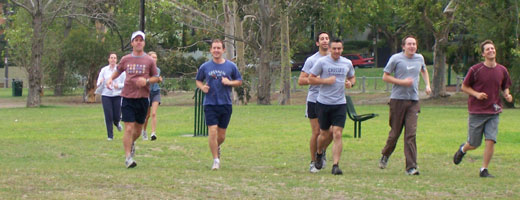 Starting position
Starting positionThe starting position of the power clean is much the same as that of the deadlift. Stand over the bar with your feet at hip-width or slightly wider. Squat down and grip the bar with an overhand grip (preferable a hook grip) slightly wider than shoulder-width. In the bottom position your feet should be flat on the floor; the bar is held firmly in your grip, your arms are straight, your shoulders are slightly forward of the bar which is very close to your shins; your chest up and your back is taut with your shoulders higher than your hips; you should be looking forward and slightly upward.
Execution
Slowly pull the bar from the floor by extending the hips and knees. Maintain the correct back position at all times. Keep the arms straight throughout this phase and ensure the bar stays as close to your body as possible.
As the bar rises from the floor it is continually accelerating. Once the bar has cleared the knees make sure you keep it close to the thighs (it may even make contact as it passes by) and explosively extend the hips and knees. Keep your heels on the floor for as long as you can to achieve maximum thrust.
Once the hips and knees are at full extension forcefully shrug the shoulders and pull yourself under the bar by flexing your elbows. At this point your heels may leave the floor, this is perfectly natural.
Upon completing the second pull - pulling yourself under the bar - you must get into position to receive the bar. The bar is received in the rack position where the elbows are pointed out to the front and the bar rests on the anterior deltoids. You will perform a quarter-squat as you receive the bar. To position yourself to receive the bar you must quickly rotate your flexed elbows under the bar and re-position your feet on the floor ready to squat.
As soon as the bar has been caught in the racked position at the bottom of the quarter-squat you should stand into a fully upright position.
Return
From the racked position you return the bar to the floor in a controlled movement. Do not lose concentration here. Take a firm grip on the bar and let your elbows drop back down under the bar. While maintaining a straight back, tilt forward slightly until the bar leaves the shoulders. With control, lower the weight to the thighs flexing the knees and hips to take some of the load. From this point lower the bar to the floor as if you were completing a deadlift.
A few pointers
- Ensure the bar is evenly loaded
- Make sure that your hands are wide enough that your arms do not interfere with the position of your legs at any point in the lift
- Your scapulae (shoulder blades) should be retracted in the starting position, think "chest up" and this will happen automatically
- The importance of a taut back cannot be understated, your back remains extended throughout the lift
- Inhale at the bottom, hold your breath and lift, exhale once your pass the transition point (this will feel natural)
- Focus on pushing the elbows through and under the bar, if you can't rack the bar properly you can't clean properly
- Practice with lighter loads until you can perform the lift in one, smooth movement










